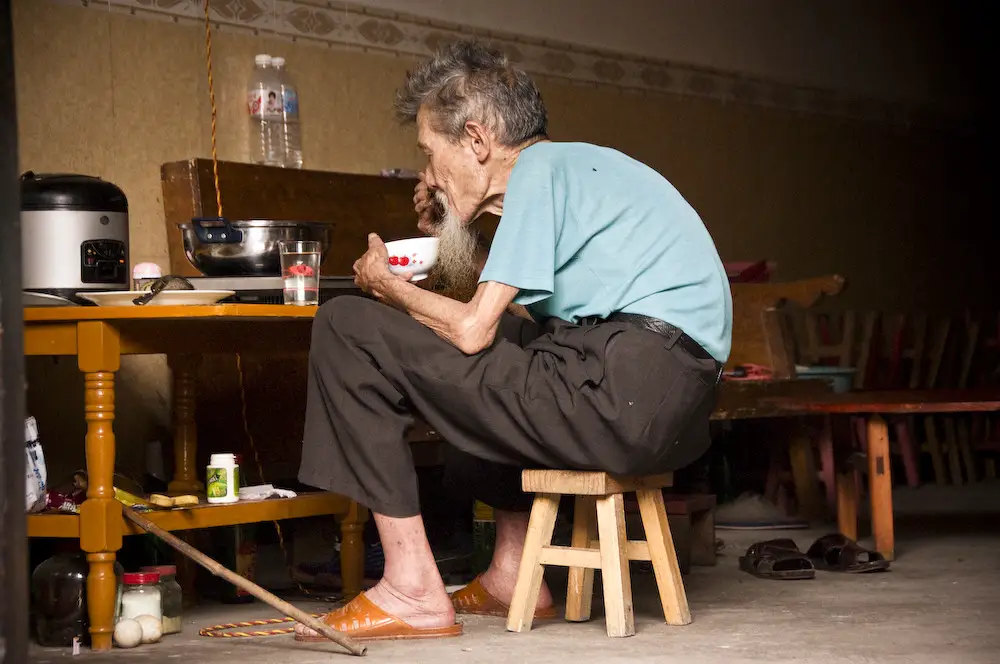Le arched back in the elderly ou round back is a posture disorder, common in the elderly, which may be due to damage to the bones of the spine which gives what is called a " dorsal hyperkyphosis ". This anomaly can also be the consequence of damage to the muscles used to straighten the spine, causing a disease called " camptocormia ».
Definition of a hunched back
Before proceeding with the definition of arched back, it is wiser to make a small anatomical reminder.
The back represents the posterior face of the human trunk which follows the head and gives attachment to the roots of the upper limbs at the level of the thorax and to those of the lower limbs on the pelvis.
It is formed by:
- La spine : located in the center and dividing into cervical spine, dorsal et lumbosacral. It is made up of 24 vertebrae between which there are intervertebral discs, and it presents physiological curvatures perfectly compensating between them: the cervical and lumbar lordosis where the column is concave (hollowed) seen in profile and the dorsal kyphosis or it is convex.
- Back muscles: very numerous, they are divided into superficial muscles such as the trapezius, large and small dorsal as well as deep muscles such as the teres minor and major or the sus and infraspinatus.
- The ribs: or at least their posterior part, which attaches to the spine.
- Tendons and ligaments: connecting the vertebrae to each other and the muscles to the bones.
- Blood vessels, lymphatics and nerve roots.
Let us now return to situations where the back can be hunched in the elderly:
- Dorsal hyperkyphosis: it is therefore an exaggeration of the natural dorsal kyphosis, essentially due to bone damage occurring due to multiple pathologies such as rheumatism,Osteoarthritis. It can also be quite simply the consequence of aging or chronic poor posture.
- Captocormia: in this situation, there is a decrease in the action of the extensor muscles, surrounding the vertebrae, and allowing the maintenance of a straight back. As a result, the back curves when standing or sitting, but becomes straight again when lying down.
Why does it occur more in older people? (Causes)
Le arched back in the elderly can be due to multiple causes. Indeed, with age many degenerative disorders occur and are the cause of bone, ligament, muscle and neurological damage.
Among the causes of arched back in the elderly, it is possible to cite:
- THEosteoporosis : more common in women over 50 due to menopause. It results from the decrease in bone density, making the bones more fragile.
This condition can be primary occurring due to advanced age or menopause as it can be secondary to taking corticosteroids, a hyperthyroidism, lack of calcium or rheumatoid arthritis.
- Degeneration of intervertebral discs: mainly as a result of ageing. The degenerative disc disease may nevertheless be due to microtraumas secondary to inappropriate sports practice or even obesity. In particular, it can cause back pain or between the shoulder blades.
The deformation or degradation of an intervertebral disc causes a joint pinching causing osteoarthritis and sometimes static disorders such as kyphosis.
- Bone trauma: the elderly are unfortunately prone to fractures due to bone fragility caused by menopause, lack of physical activity and vitamin D and calcium deficiencies.
These fractures can cause vertebral compaction or the appearance of a malunion (bone consolidation in an abnormal position).
- Tuberculosis infection or Pott's disease : generally affecting the intervertebral disc and the adjacent vertebrae, this pathology must be evoked, diagnosed and taken care of quickly, because it is at the origin of an alteration of the general state, pain, vertebral compressions, important deformations of the spine (in particular kyphosis) and sometimes even neurological damage.
- Neurodegenerative conditions: especially the Parkinson's disease, amyotrophic lateral sclerosis (Charcot's disease) or more rarely post-poliomyelitis syndrome.
- Neuromuscular diseases: motor neuron disease, neuromuscular junction disease or late spinal extensor myopathy.
- Other pathologies such as:hypothyroidism, osteomalacia, narrow lumbar canal, osteoarthritis, articular rheumatism, etc.
Back pain in the elderly
Although sometimes asymptomatic, a hunched back is often associated with back pain.
These pains are often aggravated by bad habits, namely an unsuitable posture at work accumulated during professional life (in front of a computer). The same goes for carrying heavy loads or wearing high heels, gardening, as well as prolonged (and excessive) standing or sitting.
These situations impose mechanical constraints on the vertebral structure. They sometimes end up causing vertebral compression. Hence the pain.
Osteoarthritis, osteoporosis or herniated disc can cause back pain. In 5% of cases back pain in the elderly, a inflammatory origin is found (as a inflammatory low back pain).
Other causes are possible: stress, depression or fibromyalgia.
Treatment and prevention
Unfortunately, support for arched back in the elderly is currently quite limited. Indeed, there is no specific treatment to completely correct this posture disorder.
Nevertheless, there are means and methods to prevent the occurrence and slow down the progression of kyphosis while reducing the pain that may accompany it.
In addition to physiotherapy and the practice of a physical activity regular and adapted such as swimming or yoga, it is possible to carry out some exercises of gymnastics very specific in order to correct as much as possible a round back in an elderly person.
These exercises have in common to contribute to open the rib cage by working the extension of the arms and the dorsal spine.
- Lying on your stomach, hands placed flat in front of your shoulders and elbows raised, you have to put your forehead on the ground and join your feet and knees. While inhaling, take off the bust and straighten it completely using the back muscles, while tightening the shoulder blades and sticking the elbows to the sides. This "cobra" posture should be held for five breaths.
- Another exercise consists of lying on your back this time, raising and bending your legs with the help of a chair, for example, then stretching your arms back as much as possible.
- Finally, a last exercise consists of getting into a standing position by pressing your feet together and then lean forward grabbing the ankles or legs with the hands without bending the knees. This position should be held for at least 20 seconds while breathing deeply. It is possible to repeat this exercise 4 times, resting for one minute between each repetition.
In order to straighten a hunched back, it may be appropriate to use un posture corrector (or straighten back) in some cases. This will bring the shoulders back and keep the back straight. It must be worn exceptionally, especially when the pain is greater and you want to improve your posture in the short term.
To learn more about posture correctors, see the following article.
In conclusion, the adage "prevention is better than cure" applies perfectly to the situation of the arched back in the elderly because a well-maintained back at a young age thanks to the avoidance of bad postures, the practice of bodybuilding and other physical activities makes it possible to avoid this uncomfortable situation as much as possible.
References
Straighten your arched back: 6 tips from the physiotherapist (exercises)
Dorsal kyphosis (curved back): How to correct and prevent?
https://www.edimark.fr/Front/frontpost/getfiles/25795.pdf
https://www.linfo.re/magazine/sante-beaute/le-dos-voute-un-signe-de-vieillesse
https://www.lombafit.com/douleur-entre-les-omoplates/
My name is Sidali. I am a general practitioner and Web Editor. As a healthcare professional, my mission is to contribute to the relief of my patients' ailments. Being also passionate about writing, I have the pleasure of sharing my solid medical knowledge with the greatest number of readers, by writing popular articles that are very pleasant to read.


